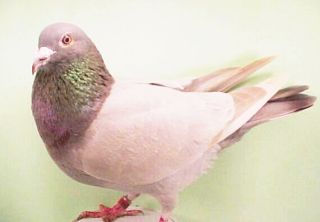
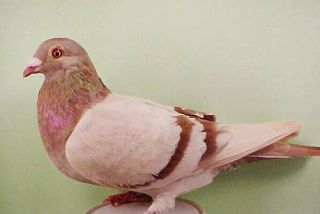
Brown symbolized with the lower case letter b is the first of three basic colors to be found in pigeons. Please bear with me for a minute as we must first wade through some genetic introduction stuff before we can begin looking at the color brown. It will only take a moment so stay with me.
OK here we go. As I said above there are three basic colors found in pigeons. Sure we can see what looks like an endless list of different colors but these are all based upon one of these first three basic types. In addition to brown (b) the other two in their order of higher dominants are blue/black (B+) and ash red (BA). The genes for these basic colors are found on the Z sex chromosome. Since sex is involved, it naturally follows that there be a difference between cocks and hens. That difference is in the number of Z chromosomes present. Cocks have two Z chromosomes and while hens have only one. This major difference is shown in the symbols used to denote them. So how do we denote the color brown for cocks and hens. This is done using an alpha code with the letter b in lower case to denote one single gene for brown. Since the symbol b is in lower case we know it to be recessive to the other two in this same basic color grouping. In addition, since the gene for brown is located on a sex chromosome and since a hen only has one Z then brown hens are symbolized as b/- to denote only one color gene and /- one sex chromosome. To further clarify let me denote how a brown cock is symbolized. Here we use b//b to denote a pair of chromosomes and in this case they are both brown. Had we used b//+ or b//B+ or even b//BA then the symbols would be telling us that the bird was carrying the gene for brown but also carried a more dominant color of blue/black or ash red and would display the more dominant of the two.
For more information on genetic symbols see Genetic Symbols and Chapter 1 - Genes, Chromosomes, Sex and Color. It may seem complicated at first but in time these symbols will make perfect sense but for now just accept them as a different type of short hand.
For now lets just remember that the symbols of (b//b) for a cock and (b/-) for a hen denote the same basic color of brown. Their difference is in the number of sex chromosomes and alternately the number of color genes to be found there. A single back slash with a minus symbol /- is only used to denote a hen.
A double back slash // denotes a pair of chromosomes be they a matching set of sex chromosomes for a male or a pair of autosome chromosomes for either sex. Since a single color gene resides on each Z chromosome a cock will have two genes for color while a hen is limited to only one. The second set of symbols to the right of the sex chromosome symbols represents all the remaining autosome or non sex chromosome pairs. An example would be the pattern genes which are symbolized as (c//c) two genes for barless, (C+//C+) two genes for bar or (CL//CL) two genes for light checker. It is important to remember that the number of autosome chromosome pairs do not differ between cocks and hens. That translates to mean there are no differences between the sexes as it relates to the number of genes found there. Now were done with the basic stuff and we can begin looking at some of the various types of browns.
Brown Bar (b/-) (C+//C+)
The Brown Bar hen shown below on the right is in the intense color form for brown. Her genetic symbols are (b/-) for brown and (C+//C+) for wild type bar at the checker loci. Another way to symbolize bar would simply be (+//+) for wild type bar pattern. A Brown hen in the Dilute form would be called a Khaki, symbolized as (bd/-), (+//+) and would appear much lighter. Note how the sun has lightened the tips of the brown bar pigeon's wing feathers. Brown will fade into a cream color and then fray with age by the suns rays. This is why Brown is not commonly found in most racing lofts. Brown wing feathers do not hold up to the stress of racing.


Brown barless cock
left,
Brown bar hen (b/-) (C+//C+)
on the right.
Their genetic symbols are (b//b) or (b/-) for brown and (c L//cL)
or (C+//C+)
for pattern.
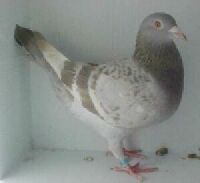

Brown,
light checker hen (b/-) (C L//CL)
left and Walt McKeen's brown t-checker (b/-)(C T//CT)
right.
The brown checker and brown t-checker below are all three of the same color brown but each is displayed in a different marking pattern and the barless is lightened in color by the dilute gene..
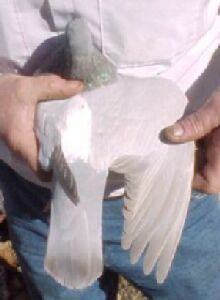
Dilute
brown or khaki barless cock (db//db) (c//c) left
and a brown bar hen (b/-) (C+//C+)
right.
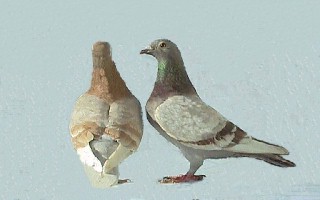
The bird above on your left is a
cream bar (d,BA/-)
(+//+) also referred to as a dilute ash-red bar. The bird on
your right is a brown bar (b/-) (+//+). Both of
these birds are hens. Their color forms are very similar but
when examined closely we see their pigment colors are indeed
different.
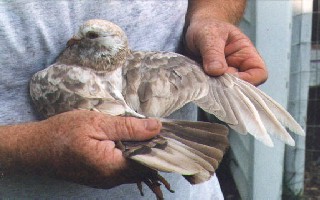
Grizzle is a modifier gene that lightens the center of the feather from the shaft outward towards their tips. A double effect (homozygous) will turn the bird into a near white with brown flecks and wing tips. Add the genes for either dilute or reduced and it lightens the brown color even more to become almost pure white. Let it fade in the sun and it will be off white until it molts out the sun faded feathers.

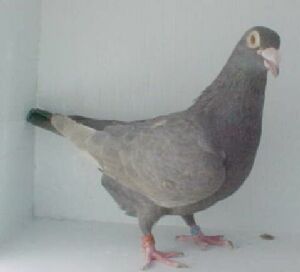
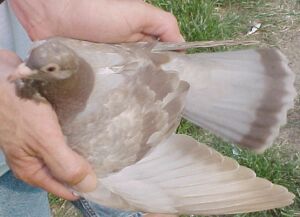
Smoky brown bar left and a brown qualmond bar on the right.
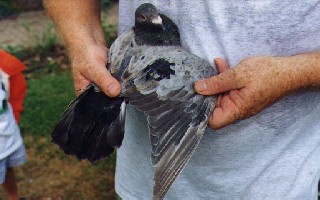
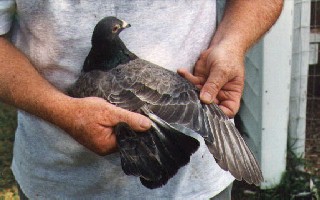
Heterozygous
gempel, pale, brown bar left with a brown bar on the left. Same birds
each photo.
A dilute blue check, which is correctly called a Silver Check, is on the left with a typical blue check facing it on the right. A head shot of the same two shown on the right. These two birds are genetically both blues and checkers. The cause of their color differences is due to the dilute gene, which tends to turn the blue/black color into a brownish dun color called silver. Please do not confuse the term silver as it is used here with the ash red mealy bars which American Racing enthusiast also call silver. It would be nice if we all used the same terms but changing personal habits is a very difficult task.
Brown as a color is often confused
with the diluted form of blue. The two checkered birds, shown above, is
an example of the difference between normal blue and diluted
blue. When displayed on a bar or checker pattern,
dilute blue is called silver. Please, do not
confuse the tern Silver with an ash-red bar or
mealy. The American practice of some
racing enthusiast in referring to mealy as silvers is
incorrect. To the rest of the
English speaking world and this includes the US Show birds, the term
for silver is in reference to a dilute blue bar or
checker. Its usage predates the racing
flyers miss use of the term. Dilute blue in combination with spread is
correctly called a dun. Some t-checker
blue dilutes because they are nearly solid in color may also be given
the term dun check.
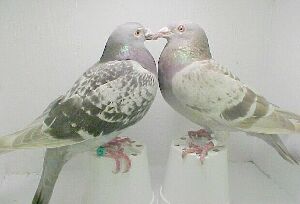
A
silver
check left with a brown check on the right.
The same two birds are again shown on the right.
If you look closely at these two checker pigeons you will see a color difference. A dilute blue silver check is genetically black pigment diluted to dun or a dull gunmetal color. The wing shield takes on a light tan look and the bar or pattern areas becomes the gunmetal off brown color. Brown, on the other hand is brown pigment. The tail bar and pattern markings are dark brown with the wing shield area a very light tan color. These two phenotypes do look very similar. Some dilutes blues being browner in appearance than others. All dilutes start life with naked skin i.e. no feather down. A dilute brown becomes a khaki.
If you place a dilute blue bar beside a brown bar you will see that the brown is softer and a more true brown in color. The dilute blue may vary some but is basically darker in shade towards black. Not much darker than brown, but noticeable when the two are side-by-side.
Another way to distinguish brown is to look for sun fading of the feathers. The suns rays affect brown much more than any other color. It fads all the exposed feathers to a cream color. As the new feathers begin to molt the bird takes on a mottled look. An example is shown below both before and after the molt.
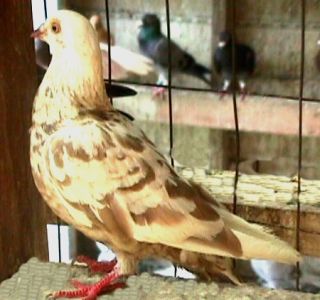
Sun faded brown spread Brown spread after a molt
A third way is to look at the eyes. A false pearl is genetically a yellow eye modified by the brown pigment. Brown will have either a false pearl (modified yellow) or a true pearl eye. A dilute blue will have yellow or true pearl but never a false pearl.
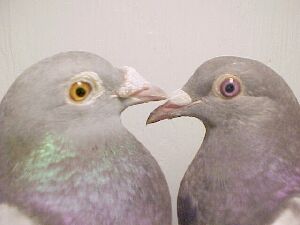
Note the
difference between the
yellow eye of the blue dilute bird compared to the false pearl eyes of
the brown. In other words while the gene for
yellow eye color can be present in brown pigeons just as it is in all
other colors, it is not displayed as being yellow. The gene
for brown modifies it to appear as false pearl.
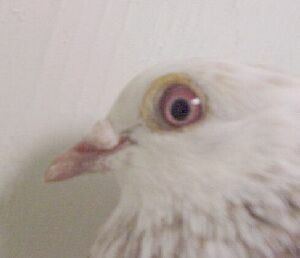
The color brown is often confused with various forms of pale and dilute. At first glance they appear to be the same color but genetically they are not. What follows are some picks of birds that look brown in color but are genetically something else.
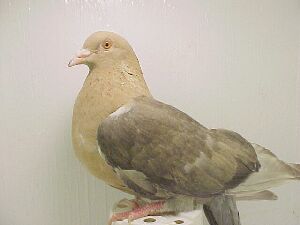
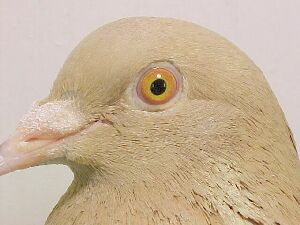

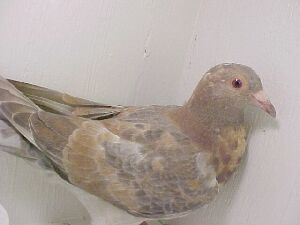
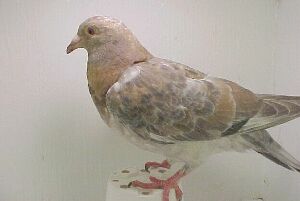
Blue
bualmond, heterozygous gimpel.